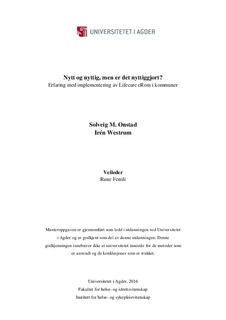| dc.description.abstract | We are both working in a municipality where a nursing home has procured Lifecare eRom, which is a module in the electronic medical record solution Gerica. The purpose of eRom is to provide quick access to a patient’s treatment plan, as well as the possibility to create documentation on touch screens site in the patient’s room. After six months we found that the system was not in use. Furthermore, we were under the impression that there had been some challenges with the implementation. Based on this, we formulated the following issue for exploration: What success factors and barriers have municipalities experienced during eRom implementation? To explore the above issue, we have used a qualitative method consisting of individual interviews of 8 key personnel, across 5 municipalities, which have all procured eRom. We chose the Normalization Process Theory and Fit Between Individuals, Tasks and Technology model (FITT) to highlight our findings. We have uncovered both success factors and barriers for implementation of eRom in our findings. Some of the success factors identified include leveraging enthusiasts during the implementation phase, management commitment, early involvement of stakeholders, proper planning, and sufficient resources. Barriers identified include reluctance to let go of old systems, insufficient skills in basic medical record documentation, resistance to change and insufficient buy-in. In addition to the above, all municipalities had experienced technical challenges during launch. We want to be clear that our conclusions are not to be considered as a complete plan for implementation. However, we do take the liberty of providing some concrete advice for other municipalities about to implement information systems. It is imperative to map out which needs the system should address, and allocate time and resources for implementation. Furthermore, we have found that project plans have to be targeted and systematic, while also including strategies for embedding the new system in processes and practical use. Hence, it is important that project managers are skilled in both project management and implementation. Keywords: Implementation, barriers, success, failure, electronic health record, information system. | nb_NO |
